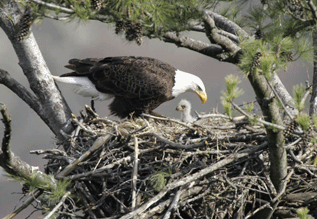South Carolina's Bald Eagles - Biology

Nesting Period
Bald eagles in South Carolina return to the same nesting territory year after year in the fall. Egg laying generally occurs in December but ranges from November to March. Clutch sizes range from one to three eggs. Incubation occurs for 5 weeks by both sexes and young remain in the nest for 10 to 12 weeks after hatching. After fledging, young birds will remain in the territory and dependent upon the adults for food for approximately 4 weeks. During this roosting period parents will bring food to the nest. The entire breeding cycle is about 7 months.
If one of the adult pair dies, the remaining mate will stay in the territory and recruit a new mate.
Bald eagles select large trees with an open limb structure for nesting and are usually located on the forest/marsh ecotone within one km (0.62 miles) of open water.
Large trees allow for stick nests that are 4 to 6 feet in diameter and 3 feet tall to be supported for many years without falling. This nest size may also reduce fratricide or premature fledging. The open limb structure provides easy access and a clear view of foraging habitat. Nesting habitats initially selected by eagles usually have limited disturbance, although eagles are showing remarkable adaptability when confronted with moderate habitat alterations, often due to expanded development in established territories. Seventy-nine percent of eagle nests are in live pine trees. Eagles also nest in live cypress and dead trees.
Trees suitable for perching and future nesting sites are also important components of stable nesting territories. Fresh, brackish and marine habitats provide suitable foraging sites and include open water, marsh and riverine types. Prime habitats are characterized by having shallow, slow moving water with abundant fish and waterfowl. Preferred sites have suitable perch and roost sites with minimal disturbance. Large manmade reservoirs in South Carolina have provided 240,000 ha (592,800 acres) of new inland eagle foraging habitat. Concentrations of eagles may be found below hydroelectric dams where they forage on injured fish. Impounded marsh managed for waterfowl is preferred foraging and nesting habitat.
Non-nesting Period
Some bald eagles from the northern part of the species range migrate to South Carolina for the winter beginning in late October and November. However, large concentrations of non-breeding birds are more common in Chesapeake Bay and the Midwest where the same communal roost sites are used year after year.
